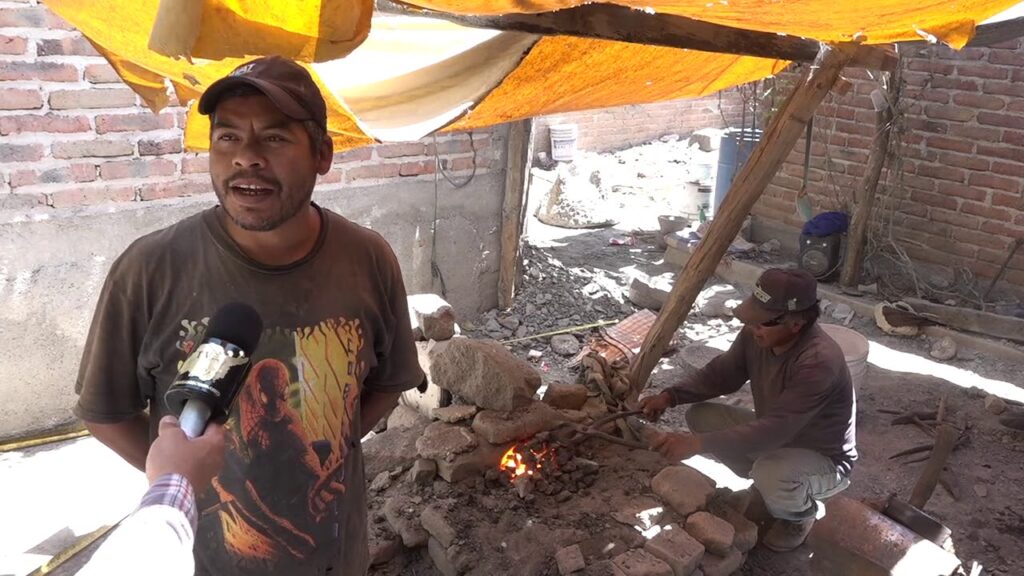Exploring Comonfort: The Birthplace of Authentic Molcajetes
Deep within the heart of Mexico, in the enchanting town of Comonfort, a centuries-old tradition endures. Known widely as the birthplace of the authentic molcajete, this charming destination beckons culinary enthusiasts and cultural travelers alike. Molcajetes, the iconic Mexican mortar and pestle, are handcrafted from volcanic rock by skilled artisans who have honed their craft over generations. Visitors to Comonfort can witness the fascinating process of creating these culinary tools that are essential in traditional Mexican kitchens.
Strolling through the cobbled streets of Comonfort, you can’t help but feel a profound connection to the past. The town’s history is palpable, with molcajete workshops dotting the landscape alongside colonial architecture. Artisans in Comonfort take pride in each molcajete they produce, ensuring every piece is a work of art. These molcajetes are treasured not just for their practical utility in grinding spices and making salsas but for their cultural significance and embodiment of Mexican heritage.
The molcajete-making process is as fascinating as the tool itself — beginning with the careful selection of volcanic stone and continuing through meticulous shaping and curing. This labor-intensive process is one that machines cannot replicate, preserving the manual artistry that imbues each molcajete with unique character. Travelers have the opportunity to engage with these craftspeople, learning about their techniques and the stories behind their work, adding a rich layer of experience to their visit.
Beyond observing molcajete production, visitors can also partake in cooking classes to understand how to use these stone tools authentically. Local chefs and home cooks are eager to share recipes passed down through generations, where the molcajete plays a starring role in preparing zesty salsas, mouthwatering guacamoles, and other traditional dishes. These hands-on experiences not only teach the practical uses of molcajetes but also highlight the pivotal role they play in the gastronomy of Mexico.
The cultural journey doesn’t end with molcajetes. In Comonfort, the confluence of history, art, and cuisine offers a rich tapestry for exploration. Delving into the town’s local markets, one can find an array of ingredients typical of the region that pair perfectly with the rustic flavors from the molcajete. Each market visit is an adventure, with vibrant colors, enticing aromas, and the welcoming smiles of vendors sharing their produce and stories. Comonfort’s indelible spirit and the craftsmanship of its molcajete artisans provide a unique window into the soul of Mexico’s gastronomic legacy.
The Journey of a Molcajete: From the Mine to Your Dining Table
The molcajete, an iconic Mexican mortar and pestle, is a quintessential artifact for Mexican cuisine that has been around for thousands of years. Crafted from volcanic rock, each molcajete tells a tale of geological formation and artisanal craftsmanship. It begins its journey deep within the earth, where volcanic activity creates the amphibolites and basalt stones that eventually become the kitchen tool that is beloved across Mexico and beyond.
In its raw state, the volcanic rock is extracted from open-air mines using traditional methods that preserve the integrity of the stone and minimize environmental impact. Skilled artisans, often with knowledge passed down through generations, then hand-carve the rock into the distinctive bowl shape of the molcajete. This process requires not only strength but also an intimate understanding of the material, as the porous nature of volcanic rock demands careful handling to create a durable and functional piece.
Once shaped, the molcajete must be cured before it can take its place at the dining table. Owners of new molcajetes traditionally grind small amounts of white rice and garlic into the bowl’s surface to fill any tiny pores in the stone and to remove grit. This curing process is both a labor of love and a rite of passage, imbuing the molcajete with the flavors and history of the meals it will help create. It’s a reminder that the best culinary tools are those seasoned with experience.
A molcajete is more than just a tool; it’s the keeper of culinary traditions and a centerpiece for the familial and communal dining experience. As it travels from the hands of the artisan to the warmth of a well-loved kitchen, it carries with it the stories of the Mexican land and its people. You’re not just bringing a utensil into your home; you’re adopting a piece of Mexico’s rich heritage, ready to be seasoned with your own family’s cooking tales.
Discover the Artisanal Process Behind Comonfort’s Famous Molcajetes
The Origins of a Millennial Tradition
Molcajetes are more than just rustic kitchen tools; they are a testament to Mexico’s rich history and culinary culture. Tracing their roots back to the pre-Hispanic period, these stone mortars and pestles are essential in creating some of the most iconic Mexican dishes. Comonfort, a small town renowned for its skilled artisans, has preserved the traditional methods of carving molcajetes from volcanic rock, each piece reflecting the heritage of an age-old craft.
Selecting the Perfect Stone
The journey of a molcajete begins with the careful selection of basalt, a dense volcanic rock that ensures both durability and the ideal texture for grinding spices and ingredients. In Comonfort, artisans venture into the local hills to harvest the stones by hand, maintaining a deep connection with the land. This manual quarrying process honors the environment and passes down a respect for nature from generation to generation, integral to their community’s philosophy.
Shaping with Simplicity and Skill
Once the perfect rock is sourced, the art of hand-carving begins. With simple tools such as hand chisels and hammers, the craftsmen of Comonfort transform rough basalt into a functional work of art. It’s a labor-intensive process that requires precision and patience. Each strike is carefully planned to ensure that the final product – the molcajete – will have the rough interior necessary to properly grind and release the full flavor of spices.
Embellishments that Tell a Story
Tradition in Comonfort dictates that each molcajete should not only be functional but also beautiful. The artisans often carve intricate designs or animal shapes – the most traditional being the molcajete shaped like a pig. These adornments are more than decorative, they narrate stories of the region’s culture and the individual artisan’s flair, making each molcajete a unique piece that holds the spirit of Comonfort.
A Labor of Love and Culture
The creation of a molcajete is steeped in cultural significance, often involving the whole artisan’s family. Parents teach their children the age-old techniques, ensuring that this vital aspect of their heritage endures. When you purchase a Comonfort molcajete, you’re not just buying a kitchen utensil; you’re supporting a family, a tradition, and a piece of Mexican history. The molcajetes are more than just tools; they are symbols of pride and the manual labor that represents the heart of Mexico’s artisanal craft.
Savor Tradition: How Comonfort Molcajetes Enhance Mexican Cuisine
In the heart of Mexico, nestled within the bustling kitchens and fragrant street food stalls, lies an artifact as significant to traditional Mexican cuisine as the ingredients themselves – the Comonfort molcajete. This ancient grinding tool is not just a vessel for food preparation; it is a cultural emblem that has been enhancing the flavors of Mexican dishes for centuries.
The molcajete, crafted from volcanic rock, is revered for its ability to finely grind and blend spices, chilies, and tomatoes, releasing their full spectrum of flavors in a way that modern kitchen appliances cannot replicate. The porous texture of the basalt stone absorbs flavors over time, which means that each dish prepared in a Comonfort molcajete carries with it a history of the meals that came before, adding depth and complexity to the cuisine.
In the preparation of salsas and guacamoles, the molcajete excels, crushing each ingredient slowly to extract maximum taste while preserving the texture that defines these iconic dishes. The pestle, known as the “tejolote,” works in conjunction with the bowl-shaped base to achieve a balance between smoothness and chunkiness – a testament to the wisdom of traditional cooking methods that have stood the test of time.
Celebrated dishes such as mole poblano or the fiery salsas characteristic of the Yucatan Peninsula owe much of their authentic taste to the molcajete’s unique grinding process. The subtle intermingling of spices, nuts, seeds, and chilies ground in a Comonfort molcajete truly embodies the soul of Mexican gastronomy.
Visitors seeking an authentic glimpse into Mexico’s culinary heritage are often captivated by the simplicity and effectiveness of the molcajete. Whether it is being used to prepare a family recipe passed down through generations, or to impress guests at a local eatery, the molcajete remains a humble yet essential tool in the continuing story of Mexico’s rich culinary landscape.
Comonfort Craftsmanship: Preserving the Legacy of Molcajete Making
In the heart of Mexico, the town of Comonfort in Guanajuato is not just famous for its charming streets and historical significance. It’s also the proud keeper of an ancient tradition that pre-dates the Spanish conquest—molcajete making. The molcajete, a three-legged mortar and pestle made from volcanic stone, is an iconic symbol of Mexican cuisine. It’s a tool that has been used for grinding spices and making salsas and guacamole for millennia, and the artisans of Comonfort have been its devoted craftsmen for generations.
Molcajete making in Comonfort is an art that requires precision and patience. The local artisans, or molcajeteros, begin with rough blocks of volcanic rock, which they skillfully hand-carve using traditional techniques. The process is labor-intensive, with each molcajete taking several hours to shape. The artisans must strike the perfect balance between functional design and aesthetic appeal, ensuring the molcajete’s distinctive rough interior surface, which is ideal for grinding and releasing the full flavor of foods.
Despite the encroachment of modern technology and mass-produced kitchen tools, the molcajeteros of Comonfort remain undeterred. Their commitment to their craft is not merely a means to earn a living; it is an act of cultural preservation. By continuing to produce molcajetes in the authentic method, they uphold a piece of Mexican heritage, ensuring that the rich flavors and traditions of their country are kept alive in kitchens around the world.
Tourists and culinary enthusiasts who visit Comonfort can witness this captivating craft firsthand. They observe as experienced molcajeteros chisel away at stone with a focus that has been passed down through the ages, an echo of ancestral methods. For those who take a molcajete home, it’s not just a tool—it’s a treasure, a tangible connection to the vibrant history and spirit of Mexican culture. As they use it to crush spices or to mix a perfect salsa, they partake in a legacy that has withstood the test of time, thanks to the unwavering dedication of the Comonfort craftsmen.



